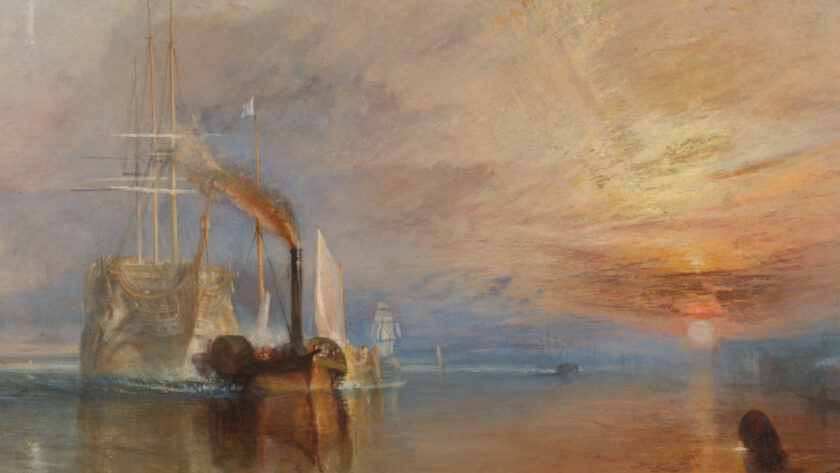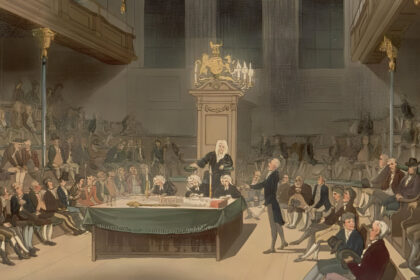JMW Turner didn’t just paint landscapes, he lit them on fire. Not literally, of course, though he was fond of a dramatic blaze or two. His sunrises blaze with golden fury, his storms crackle with angry skies, and his seas churn with all the rage of Poseidon on a bad day. By the time he died in 1851, Turner had changed the way the British saw the world around them, and in many ways, he set the stage for modern art. But to understand Turner, you need to know the man behind the myth. A man who shunned polite society, muttered to himself in paint-splattered rooms, and could conjure the sublime from little more than a sketch and a storm cloud.
From barber’s son to Royal Academy prodigy
Joseph Mallord William Turner was born in Covent Garden, London, in 1775. His father was a barber and wig maker, his mother suffered from mental illness, and his younger sister died young. These early years were hard, marked by grief and instability, but they were also oddly freeing. His father, supportive and perhaps slightly bemused, let his son cover the walls with sketches. By the age of 14, Turner was studying at the Royal Academy of Arts, and by 15, he was exhibiting there.
Even as a teenager, Turner’s work had a maturity and intensity that turned heads. While other students fussed over form, he was obsessed with light. His early watercolours showed an uncanny ability to capture mist and atmosphere – a hint of the storm to come.
Landscapes, shipwrecks and stormy seas
In a time when landscape painting was considered second-rate, Turner elevated it to high art. He roamed the country sketching castles, rivers, and cathedrals, often in a style that began as topographical and ended somewhere near transcendental. The more he travelled, the looser and more lyrical his work became. His skies boiled. His seas heaved. Ships capsized, mountains loomed, rain lashed. Nature, in Turner’s hands, was not something to be admired politely – it was something that could kill you.
He was especially drawn to water. The ocean wasn’t just a subject; it was a metaphor. Paintings like The Shipwreck (1805), Snow Storm – Steam-Boat off a Harbour’s Mouth (1842), and The Slave Ship (1840) are turbulent, heart-wrenching works, often veering towards abstraction. It’s said that for one storm scene, Turner lashed himself to the mast of a ship to experience the terror first-hand. Whether true or not, it’s exactly the kind of story you want to believe about him.
The painter of light
Turner’s most enduring nickname is “the painter of light,” and it’s not hard to see why. Long before the Impressionists picked up their pastel palettes, Turner was experimenting with colour, tone, and atmosphere in ways that baffled critics and delighted his followers. His later works, in particular, verge on the ethereal. Paintings like Rain, Steam and Speed – The Great Western Railway (1844) dissolve into mist and motion, more sensation than scene. You can almost feel the wind on your face and the grit in your eyes.
This focus on light wasn’t just technical – it was philosophical. Turner saw the world in flux. Industrialisation was transforming the British landscape, and his work captured that shift with all its beauty and brutality. Trains roared across meadows, steamships replaced sailing vessels, and cities belched smoke into golden skies. Turner didn’t shy away from these changes; he turned them into art.
A man of mystery
Despite his fame, Turner was an intensely private man. He never married, though he had two daughters with his housekeeper. He lived alone for much of his life and was known for his eccentricities. He could be gruff, secretive, and socially awkward, but also generous and deeply committed to his art. When not painting, he spent time obsessively reworking his collection, often refusing to sell pieces he felt weren’t finished, even if everyone else disagreed.
He also had a curious relationship with money. While he earned a fortune during his lifetime, he hoarded it, lived frugally, and left the bulk of his estate to establish a fund for “decayed artists.” His final years were spent in near anonymity, living under the name “Mr Booth” with a widow in Chelsea, where he died in 1851.
His last words, fittingly, were: “The sun is God.”
His legacy
Today, Turner is widely regarded as one of Britain’s greatest artists. He revolutionised landscape painting, influenced generations of artists (including Monet and the Impressionists), and left behind a vast body of work that continues to dazzle.
The Turner Bequest, which included around 300 oil paintings and 30,000 sketches and watercolours, was left to the British nation and now forms the core of the Turner collection at Tate Britain. The annual Turner Prize, established in 1984, is named in his honour and remains one of the UK’s most prestigious, and controversial, art awards.
What makes Turner so remarkable isn’t just his technique or subject matter. It’s his ability to take the ordinary and make it extraordinary. A fishing boat becomes a symbol of human fragility. A shaft of light becomes a vision of the divine. In Turner’s world, nature doesn’t sit quietly, it roars.
Places to explore Turner’s world
Tate Britain, London
Home to the largest collection of Turner’s works anywhere, including many of his most famous paintings. The Clore Gallery, designed by James Stirling, is dedicated to his art.
Petworth House, West Sussex
This stately home has several original Turner paintings on display, as well as a room he used as a studio during visits. The surrounding landscape, which Turner sketched frequently, is worth a wander.
Turner Contemporary, Margate
Turner visited Margate regularly and was inspired by the light over the sea here. The modern gallery bearing his name is a hub for contemporary art but keeps the Turner spirit alive.
The Royal Academy of Arts, London
Where Turner trained and later became a full academician. The annual Summer Exhibition still has echoes of Turner’s era.
Cheyne Walk, Chelsea
Where Turner lived out his final years under an assumed name. There’s no grand monument, but a blue plaque marks the house.
Turner was not an easy man, nor was he a comfortable artist. He painted chaos, embraced change, and refused to be boxed in. But in doing so, he gave us a new way to see the world, not as it is, but as it feels. The next time you watch the sky shift colour before a storm or see the sun glint off wet pavement, you might just spot a bit of Turner in it.
He didn’t tame the elements. He captured their soul.


